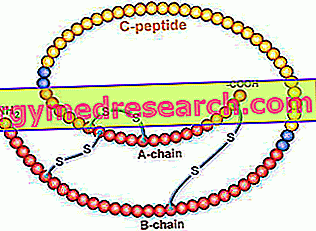See also: low carb diets
What is that
Ketogenic diet: definition
The ketogenic diet is a nutritional strategy based on the reduction of food carbohydrates, which "forces" the body to independently produce glucose necessary for survival and to increase the energy consumption of fat contained in adipose tissue.

Ketogenic diet means " diet that produces ketone bodies " (a metabolic residue of energy production).
Regularly produced in minimal quantities and easily disposable with urine and pulmonary ventilation, ketone bodies reach a higher level than the normal condition. The undesired excess of ketone bodies, responsible for the tendency to lower blood pH, is called ketosis. Also the motor activity affects, positively or negatively (depending on the case), on the condition of ketoacidosis.
The presence of ketone bodies in the blood has different effects on the body; some are considered useful in the weight loss process, others are "collateral".
There is not just one type of ketogenic diet and all dietary styles that provide less carbohydrate than necessary, such as the Atkins diet or LCHF (low carb, high fat - low carbohydrate, high fat) are ketogenic. Some types of ketogenic diet are used in the clinical setting, but these are systems mainly used in the field of fitness and aesthetic culture.
Features
Characteristics of the ketogenic diet
The ketogenic diet (in English ketogenic diet or keto diet) is a nutritional scheme:
- Low in calories (low-calorie diet)
- Low percentage and absolute carbohydrate content (low carb diet)
- High percentage of proteins, even if the absolute quantity (in grams) is more often medium
- High percentage and absolute lipid content.
Purposes
Application of the ketogenic diet
This food strategy is used above all in three contexts (very different from each other):
- Weight loss (preferably under medical supervision)
- Food therapy of certain metabolic pathologies such as hyperglycemia and hypertriglyceridemia (ONLY under medical supervision)
- Reduction of symptoms associated with childhood epilepsy (ONLY when the subject is not responding to drug therapy and ONLY under medical supervision).
What to eat
What to eat in the ketogenic diet?
The most important aspect to reach the state of ketosis is to eat foods that do not contain carbohydrates, to limit those that bring few and avoid the foods that are rich in them.
The recommended foods are:
- Meat, fishery products and eggs - the basic food group
- Cheeses - The fundamental group of foods
- Fats and seasoning oils - V fundamental group of foods
- Vegetables - VI and VII fundamental group of foods.
The foods advised against are:
- Cereals, potatoes and derivatives - III fundamental food group
- Legumes - IV fundamental food group
- Fruits - VI and VII fundamental group of foods
- Sweet drinks, various sweets, beer, etc.
Generally, it is recommended to maintain a carbohydrate intake of less than or equal to 50 g / day, ideally organized in 3 portions with 20 g each.
A rather strict guideline for a correct ketogenic diet involves an energy distribution of:
- 10% from carbohydrates
- 15-25% protein (not forgetting that proteins, also containing glucogenic amino acids, participate in supporting the level of glucose in the blood)
- 70% or more from fat.
How to understand being in ketosis?
To identify a possible state of ketosis, it is possible to carry out urine tests (with special urine strips), blood (blood ketone gauges) or breath (ketone analyzer in the breath). However, you can also rely on certain "revealing" symptoms, which require no tests:
- Dry mouth and feeling thirsty
- Increase in diuresis (for the filtration of acetoacetate)
- Acetal breath or sweat (due to the presence of acetone) that escapes through our breath
- Appetite reduction
- Fatigue.
How many ketones must be present in the blood?
There is no real distinction between ketosis and non-ketosis. The level of these compounds is influenced by diet and lifestyle. However, it is possible to state that there is an optimal range for the correct functioning of the ketogenic diet:
- Below 0.5 mmoles of ketones per liter of blood is not considered ketosis.
- Between 0.5-1.5 mmol / l we speak of light ketosis
- With 1.5-3 mmol / l the ketosis is defined as optimal
- Values of over 3 mmol / l, in addition to not being more effective, compromise the state of health (especially in the case of type 1 diabetes mellitus)
- Values over 8-10 mmol / l are difficult to achieve with the diet. Sometimes they are obtained in diseases or through inadequate physical activity; relate to even very serious symptoms.
How does it work
Notes on energy production
Cellular energy production takes place thanks to the metabolization of some substrates, above all glucose and fatty acids. Mostly, this process begins in the cytoplasm (anaerobic glycolysis - without oxygen) and ends in the mitochondria (Krebs cycle - with oxygen - and ATP recharge). Note : the muscle cells are also able to oxidize good amounts of branched amino acids. However, two fundamental aspects must be emphasized:
- Some tissues, like the nervous one, work "almost" exclusively with glucose
- The correct cellular use of fatty acids is subordinated to the presence of glucose which, if deficient, is produced by the liver by means of neoglucogenesis (starting from substrates such as glucogenic amino acids and glycerol).
Note : by itself, neoglucogenesis is not able to definitively satisfy, in the long term, the metabolic demands of the whole organism.
This is why carbohydrates, although they cannot be defined as "essential", should be considered essential nutrients and a minimum intake of 180 g / day is recommended (the minimum quantity to guarantee the full functionality of the central nervous system).
Residual ketone bodies
We now explain how the release of ketone bodies occurs.
During energy production, the fatty acids are first reduced to CoA (coenzyme A) and, immediately afterwards, allowed to enter the Krebs cycle. Here they bind to the oxalacetate to reach a further oxidation, until it ends with the release of carbon dioxide and water. When the production of acetyl CoA by lipolysis exceeds the absorption capacity of oxalacetate, the formation of the so-called ketone bodies occurs.
Note : each ketonic body is formed by two molecules of acetyl CoA.
Types of ketone bodies
The ketone bodies are of three types:
- Acetone
- acetoacetate
- 3-hydroxybutyrate.
Disposal of ketone bodies
The ketone bodies can be further oxidized, in particular from muscle cells, from the heart and to a lesser extent from the brain (which uses them especially in the absence of glucose), or eliminated with urine and pulmonary ventilation. Needless to specify that increasing the ketone bodies in the blood also increases the workload of the kidneys.
If the production of ketone bodies exceeds the disposal capacity of the organism, they accumulate in the blood, giving rise to the so-called ketosis.
Ketosis, ketoacidosis and metabolic acidosis
Also called ketoacidosis, this condition lowers the blood pH defining the typical picture of metabolic acidosis (typical of untreated diabetics). In extreme cases, acidosis can lead to coma and even death.
Motor activity and ketoacidosis
The role of motor activity on ketoacidosis is, in a sense, contradictory. Starting from the assumption that the use of the ketogenic diet is however a metabolic forcing - which in the long run can lead to unpleasant consequences, even in a young and well-trained organism - it is necessary to specify that:
- On the one hand, intense physical exercise increases the energy demands of glucose favoring the production and accumulation of ketone bodies.
- On the other hand, moderate exercise increases the oxidation of ketone bodies by opposing their accumulation and the negative effects that they can exert in the body.
neoglucogenesis
We have already said that the organism still needs glucose and that, if it is not taken with the diet, it must be produced with neoglucogenesis. Indispensable for the correct functioning of nerve tissue in particular, glucose is also necessary to complete lipid oxidation.
Gluconeogesis is a process that leads to the formation of glucose starting from the carbon skeleton of some amino acids (called glucogenic, or that give rise to oxalacetate); to a lesser extent, also from glycerol and lactic acid. This process ensures a constant supply of energy even in conditions of glucose deficiency, but forces the liver and kidneys to work harder to eliminate nitrogen.
Advantages
Benefits of the ketogenic diet
The ketogenic diet can have advantages:
- It facilitates weight loss thanks to:
- Total calorie reduction
- Constant blood glucose and insulin maintenance
- Increased consumption of fat for energy purposes
- Increased global caloric expenditure due to increased specific dynamic action and "metabolic work"
- It has an anorectic effect
- It can be useful in countering the symptoms of epilepsy that does not respond to drugs, especially in children.
Disadvantages
Disadvantages of the ketogenic diet
The ketogenic diet can also show several disadvantages, most of which depend on the levels of ketone bodies present in the blood:
- Increased renal filtration and diuresis (excretion of ketone bodies and nitrogenous waste)
- Tendency to dehydration
- Increased workload of the kidneys
- Possible toxic effect on the kidneys by ketone bodies
- Possible hypoglycemia
- Possible hypotension
- Keto-flu or "keto-flu" in English; it is a syndrome linked to the poor adaptation of the organism after 2-3 days from the start of the ketogenic diet. It Includes:
- Headache
- Fatigue
- Dizziness
- Light nausea
- Irritability.
- In the most sensitive subjects, increased chance of fainting (due to the previous two)
- More tendency to:
- Muscle cramps
- Constipation
- Sensation of heart palpitations
- Increased liver workload, due to increased neoglucogenesis, transamination and deamination processes
- In the presence of intense and / or prolonged motor activity, muscle catabolism
- It is unbalanced and tends to limit the intake of some very important nutrients
- It can be particularly harmful for:
- Malnourished subjects such as, for example, those affected by eating disorders (DCA)
- Type 1 diabetics
- Pregnant and nurse
- Those who already suffer from liver and / or kidney diseases.

Scientific Updates
Carbohydrates: do they compromise health and promote mortality?
Premise
Observing and carefully comparing the list of advantages with that of the disadvantages, it seems that the ketogenic diet is not a real "manna from heaven". In fact, it is a method contraindicated in several situations; it also requires a certain "individual sensitivity", or the use of analytical tools that ensure that it fits perfectly within the "ideal ketosis". It is undoubtedly a rather cumbersome and not very spontaneous strategy. However, it is still widely used today in the field of weight loss and food therapy against chronic hyperglycemia.
Scientific research suggests that, if used correctly, the ketogenic diet can not only be useful, but also remedy some damage caused by carbohydrate-rich diets (obesity, type 2 diabetes, hypertriglyceridemia, etc.).
PURE Study by Dehghan et al., 2017
PURE (Dehghan et al., 2017) is a prospective (or cohort) study that has observed over 135, 000 participants from 18 countries for many years. Excluding subjects with pre-existing cardiovascular diseases (except for diabetes), after a 7.4-year follow-up from the start of the observation, more than 10, 000 deaths or cardiovascular events (such as heart attack and stroke) occurred related to the parameters the start of the study (socio-economic factors, nutrition and motor activity questionnaires); it turned out that the intake of carbohydrates increases the total mortality while the lipids (indistinctly saturated and unsaturated) decrease it. No link was noted between fat consumption and cardiovascular events or other types of related mortality, with the exception of saturated fats, which unexpectedly associated with a lower risk of stroke.
The release of insulin caused by the intake of glucose and the activation of the corresponding signaling cascade can be considered the main reason that increasing the carbohydrate intake leads to mortality. As demonstrated by the high incidence of tumors in diabetics, hyperinsulinemia is a very important malignant growth factor.
Reduction of glucose absorption
From a therapeutic perspective, if carbohydrates are important factors in promoting mortality, not only the reduction of total intake, but also the inhibition of the absorption and metabolism of carbohydrates should extend the life span.
- Acarbose is an alpha-glucosidase inhibitor, an intestinal enzyme that releases D-glucose from complex carbohydrates (especially starch). It has been used in the treatment of diabetics to limit the absorption of carbohydrates in the intestine since the 1980s. In line with the role of carbohydrates in impairing health, acarbose has been shown to prolong lifespan in mice (Harrison et al., 2014).
- Renal sodium-glucose co-transporter 2 inhibitors (SGLT-2) promote the removal of D-glucose from the blood through urine. These newly developed inhibitors are used for the treatment of diabetics. The potential effects on the lifespan of organisms or humans have not yet been published but seem justified.
- The antidiabetic metformin, currently investigated with regard to the extension of life span (TAME study), reduces the production of glucose (gluconeogenesis) from the liver and causes a reduction in blood sugar.
Nutrient combination
In mice, the almost complete removal of carbohydrates (<1%) to obtain a ketogenic diet has improved life expectancy compared to a high-carbohydrate diet. On the other hand, Roberts et al., 2017 observed that by reconstituting even just 10% of the energy in simple sugars this positive effect vanishes. By replacing sugars with complex carbohydrates the parameters improve significantly; sugars are therefore the worst effect. It has been shown that combining a high-fat diet with medium percentages of simple sugars results in negative results; however, the worst ones were obtained by combining very high amounts of fat and sugar. Furthermore, an extension of the lifespan of mice was noted by replacing nutritional proteins with carbohydrates, independent of total calories (Solon-Biet et al., 2014). Taken together, these studies suggest that dietary sugar may be a very important, but not unique, limiting factor on rodent health.
Criticism in the study
The PURE study has been criticized for manipulating the statistical effect of its results. In particular, nutritional habits dependent on income and geography of specific subgroups would not be applicable to high-income western societies (which had however been included in PURE). Indeed, Dehghan et al. (2017) have not analyzed which specific source of carbohydrates (refined sugar / carbohydrates or whole grains) can contribute to the harmful effects of carbohydrates, and how income can influence the quality of dietary choices. However, an additional re-elaboration was subsequently proposed on family income and wealth, as well as on the socioeconomic status of the respective country, demonstrating that these variables in no way influenced the main observations of the study (Appendix, page 34 by Dehghan et al., 2017).
Conclusion of the study
The PURE study team believes that current nutritional recommendations, especially regarding refined carbohydrates and sugar, should be radically reconsidered. Furthermore, pharmacological options to simulate low-carbohydrate nutrition (ie, without the need for an effective reduction in carbohydrate intake) should be considered a useful and practical approach to changes in nutritional habits for the general population.
Reflections
Ketogenic diet: is it worth it?
Avoiding taking glucose through the diet and forcing the body to use the less convenient amino acids is a somewhat "questionable" strategy, because it poisons the entire organism, tends to fatigue the liver and kidneys unnecessarily, makes the nervous system and muscles less efficient.
On the other hand, the potential negative effects of SERIOUS amounts of ketogenic diets are more limited than many believe; or rather, the ketogenic diet alone, in the short term, does NOT cause kidney failure, liver failure, reduced basal metabolic rate and impaired thyroid, bone demineralization etc. What could instead happen in the long term is still the subject of studies; certainly, the ketogenic diet should not be understood as a definitive food strategy, especially given the contraindications it may have in certain situations.
It is however undoubted that all this work, in addition to keeping insulin levels low (responsible, together with the excess of calories, for the adipose deposit), increases the amount of calories burned, stimulates the secretion of hormones and the production of metabolites which they favor the disposal of fat and suppress appetite. For all these reasons the "slimming" effectiveness of the ketogenic diet is all in all high.
The ketogenic diet works immediately but subjects the body to continuous and unhealthy stress. If poorly designed, especially when badly distributed or excessively restrictive, the ketogenic diet must be abandoned and replaced with other less dangerous and equally effective dietary strategies.
Although it is also used in the treatment of epilepsy that does not respond adequately to drugs, in other contexts the ketogenic diet can be particularly harmful. It is in fact one of the most common "extreme" food strategies in certain eating disorders (DCA). If performed by a person suffering from type 1 diabetes mellitus (even if there really is no reason for it), it requires a great deal of attention and medical support, because it could have serious health consequences. Moreover, being strongly unbalanced, it can compromise the nutritional demand of the pregnant woman or nurse.



